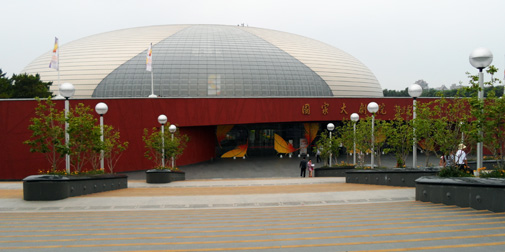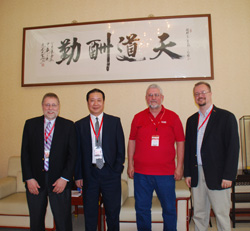News From David Grindle, USITT Executive Director
Executive Director's column

The Chinese National Theatre (known as The Egg) contains three separate performance spaces, all of which were part of a tour when Joe Aldridge and David Grindle went to Beijing for the PALM Expo.
Photo/Joe Aldridge
Seventeen hundred exhibitors were there with everything from moving lights to python skins. Joe Aldridge and I didn't know what would greet us in Beijing at the PALM Expo and China Entertainment Technology Summit in May, but it sure wasn't python skins.
Joe and I were guests of the China Entertainment Technology Association (CETA). I had been asked to speak as part of the 10th annual summit, and Joe had been invited to come as President of USITT. It was a great way to end his term as President and grow relations with our colleagues around the world at the same time. It was also an amazing way to see how many of our members are marketed in other parts of the globe.

Steve Terry, Zhu Xincon, President of CETA, USITT President Joe Aldridge and Executive Director David Grindle held a discussion during the PALM Expo in Beijing in May.
The President and Vice-Presidents of CETA met with Joe and me to discuss ways we could cooperate as organizations especially in the realm of training. They are building a few theatres in China, if you've not heard. Hundreds of theatres all over the nation, most of them on a scale we would call huge. But many not. To operate these theatres, they need well trained technicians, and we as a nation are regarded as having some of the finest training in the world. So discuss we did. We've a long way to go, but the talks are started and the dialogue continues.
I've had the fortune to travel many places in the world, but nothing is on the scale of China. The great cathedrals of Europe are big, the buildings of the Forbidden City, Tiananmen Square, and the National Theatre in downtown Beijing are immense. The National Theatre (or as it is called, The Egg) houses three venues ranging from 1,200 to 2,300 seats. The Drama Theatre, Opera House, and Concert Hall are all under one large dome with underground galleries extending out from the center on each side. To walk backstage, you follow colored lines on the floor to make sure you get to the proper venue. But backstage is a dream land. Great technology and crews to work it abound in this facility. However, there are many venues on that scale still under construction needing more equipment and more crews.
Mr. Zhu, the president of CETA, reminded people attending the event that China is the largest consumer of entertainment technology in the world. This is no doubt the case with the number of exhibitors showing at the PALM Expo. However, just as China embraces the new robotic technology we saw, they also show, at the same expo, the traditional Chinese instruments and the tools required to craft them (back to the python skins). Entertainment technology takes an entirely different concept in their minds. It isn't just the newest technologies, but the old that are displayed. Zithers, beautiful stringed instruments, were on display. Some were carved out of rosewood and other elegant natural materials; others were electrified and made of Lucite. The two sat side by side and were admired and played by the folks wandering the show.
I sometimes get caught up in the nifty new technologies when I'm at these shows. The projection mapping, LED walls, and automation dazzle the eyes. But in this case, so did the luthier carving a new violin, the instrument maker making a zither, or the drummer stretching skin over a djembe.
These too are entertainment technology; they're just age old.
I guess it was put in perspective when our translator, Tina, a friend of Fellow Michael Ramsaur, was taking us through the National Theatre. There was an amazing Chinese lantern sitting in the lobby. As Joe and I marveled at the craftsmanship and beauty of it, we asked Tina about it. "Oh, it's only about 500 years old," she said.
After all, that's relatively new technology in a city with a history dating back to before the 11th century BC.

The PALM Expo program featured photos of exhibit presenters, including David Grindle


We'd like to hear your comments on this story.
Please e-mail David at david@office.usitt.org.
Follow me on Twitter — #USITTExec